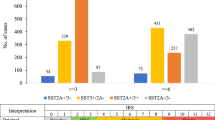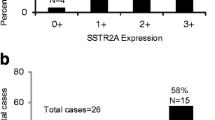Abstract
The long-acting somatostatin analogs represent important weapons in treatment protocols of patients with neuroendocrine tumors. Because these peptides preferentially bind to the specific somatostatin receptors, the targeted therapy requires detection of them. As one of the national consulting centers, here we present the results of the immunohistochemically positive neuroendocrine neoplasms diagnosed between 2010 and 2014. Twenty-four paraffin-embedded cases (14 females 10 men, 21–79 years) from different localizations were found to express somatostatin-receptor type 2 (SSTR2). None of the patients has received previous hormonal therapy. The immune reactions have shown membranous, cytoplasmic or mixed patterns. There was no correlation between the expression and the chromogranin A levels, the grades or the hormonal activity/inactivity of the given neoplasms. Our results show that the immunohistochemical detection of SSTR2 is a quick, reliable and effective tool that provides useful information to the oncologists for the therapeutic decision. Because the incidence of the neuroendocrine tumors is still low, centralized pathological units are needed to perform such technique.

Similar content being viewed by others
References
Pollak MN, Schally AV (1998) Mechanisms of antineoplastic action of somatostatin analogs. Proc Soc Exp Biol Med 217:143–152
Rai U, Thrimawithana TR, Valery C, Young SA (2015) Therapeutic uses of somatostatin and its analogues: Current view and potential applications. Pharmacol Ther 152:98–110
Albertelli M, Nazzari E, Sciallero S, Grillo F, Morbelli S, De Cian F, Cittadini G, Ambrosetti E, Ciarmiello A, Ferone D (2017) Anti-tumoral effects of somatostatin analogs: a lesson from the CLARINET study. J Endocrinol Investig May 26. https://doi.org/10.1007/s40618-017-0692-0
Chalabi M, Duluc C, Caron P, Vezzosi D, Guillermet-Guibert J, Pyronnet S, Bousquet C (2014) Somatostatin analogs: does pharmacology impact antitumor efficacy? Trends Endocrinol Metab 25:115–127
Pyronnet S, Bousquet C, Najib S, Azar R, Laklai H, Susini C (2008) Antitumor effects of somatostatin. Mol Cell Endocrinol 286:230–237
Pan MG, Florio T, Stork PJS (1992) G protein activation of a hormone-stimulated protein-tyrosine phosphatase in human tumor cells. Science 256:1215–1217
Teijeiro R, Rios R, Costoya JA, Castro R, Bello JL, Devesa J, Arce VM (2002) Activation of human somatostatin receptor 2 promotes apoptosis through a mechanism that is independent from induction of p53. Cell Physiol Biochem 12:31–38
Murray RD, Kim K, Ren SG, Chelly M, Umehara Y, Melmed S (2004) Central and peripheral actions of somatostatin on the growth hormone–IGF-I axis. J Clin Invest 114:349–356
Bosman FT, Carneiro F (2010) WHO Classification of Tumours, Pathology and Genetics of Tumours of the Digestive. IARC Press, System
Narayanan S, Kunz PL (2015) Role of somatostatin analogues in the treatment of neuroendocrine tumors. Natl Compr Canc Netw 13:109–117
Childs A, Vesely C, Ensell L, Lowe H, Luong TV, Caplin ME, Toumpanakis C, Thirlwell C, Hartley JA, Meyer T (2016) Expression of somatostatin receptors 2 and 5 in circulating tumor cells from patients with neuroendocrine tumors. Br J Cancer 115:1540–1547
Gonzalez B, Vargas G, Ramirez C, Asa S, Cheng S, Sandoval C, Mercado M (2014) Cytoplasmic expression of SSTR2 and 5 by immunohistochemistry and by RT/PCR is not associated with the pharmacological response to octreotide. Endocrinol Nutr 61:523–530
Sclafani F, Carnaghi C, Di Tommaso L, Rodari M, Destro A, Rimassa L, Giordano L, Chiti A, Roncalli M, Santoro A (2011) Detection of somatostatin receptor subtypes 2 and 5 by somatostatin receptor scintigraphy and immunohistochemistry: clinical implications in the diagnostic and therapeutic management of gastroenteropancreatic neuroendocrine tumors. Tumori 97:620–628
Diakatou E, Alexandraki KI, Tsolakis AV, Kontogeorgos G, Chatzellis E, Leonti A, Kaltsas GA (2015) Somatostatin and dopamine receptor expression in neuroendocrine neoplasms: correlation of immunohistochemical findings with somatostatin receptor scintigraphy visual scores. Clin Endocrinol 83:420–428
Mehta S, de Reuver PR, Gill P, Andrici J, D’Urso L, Mittal A, Pavlakis N, Clarke S, Samra JS, Gill AJ (2015) Somatostatin Receptor SSTR-2a Expression is a Stronger Predictor for Survival Than Ki-67 in Pancreatic Neuroendocrine Tumors. Medicine (Baltimore) 94:e1281
Wang Y, Wang W, Jin K, Fang C, Lin Y, Xue L, Feng S, Zhou Z, Shao C, Chen M, Yu X, Chen J (2017) Somatostatin receptor expression indicates improved prognosis in gastroenteropancreatic neuroendocrine neoplasms, and octreotide long-acting release is effective and safe in Chinese patients with advanced gastroenteropancreatic neuroendocrine tumors. Oncol Lett 13:1165–1174
Qian ZR, Li T, Ter-Minassian M, Yang J, Chan JA, Brais LK, Masugi Y, Thiaglingam A, Brooks N, Nishihara R, Bonnemarie M, Masuda A, Inamura K, Kim SA, Mima K, Sukawa Y, Dou R, Lin X, Christiani DC, Schmidlin F, Fuchs CS, Mahmood U, Ogino S, Kulke MH (2016) Association Between Somatostatin Receptor Expression and Clinical Outcomes in Neuroendocrine Tumors. Pancreas 45:1386–1393
Brunner P, Jörg AC, Glatz K, Bubendorf L, Radojewski P, Umlauft M, Marincek N, Spanjol PM, Krause T, Dumont RA, Maecke HR, Müller-Brand J, Briel M, Schmitt A, Perren A, Walter MA (2017) The prognostic and predictive value of sstr2-immunohistochemistry and sstr2-targeted imaging in neuroendocrine tumors. Eur J Nucl Med Mol Imaging 44:468–475
Liu Q, Cescato R, Dewi DA, Rivier J, Reubi JC, Schonbrunn A (2005) Receptor signaling and endocytosis are differentially regulated by somatostatin analogs. Mol Pharmacol 68:90–101
Pisarek H, Pawlikowski M, Kunert-Radek J, Winczyk K (2010) Does the response of GH-secreting pituitary adenomas to octreotide depend on the cellular localization of the somatostatin receptor subtypes SSTR2 and SSTR5? Endokrynol Pol 61:178–181
Acknowledgements
The excellent technical assistance of Zsuzsa Kaminszky is highly appreciated.
Author information
Authors and Affiliations
Corresponding author
Ethics declarations
Conflict-of-interest
The authors declare no conflict of interest.
Rights and permissions
About this article
Cite this article
Zalatnai, A., Galambos, E. & Perjési, E. Importance of Immunohistochemical Detection of Somatostatin Receptors. Pathol. Oncol. Res. 25, 521–525 (2019). https://doi.org/10.1007/s12253-018-0426-4
Received:
Accepted:
Published:
Issue Date:
DOI: https://doi.org/10.1007/s12253-018-0426-4




